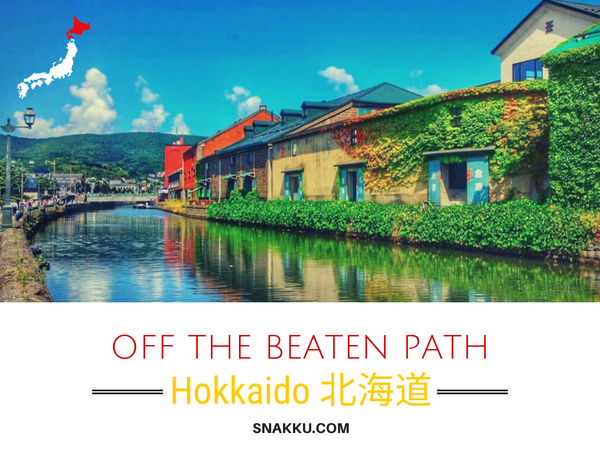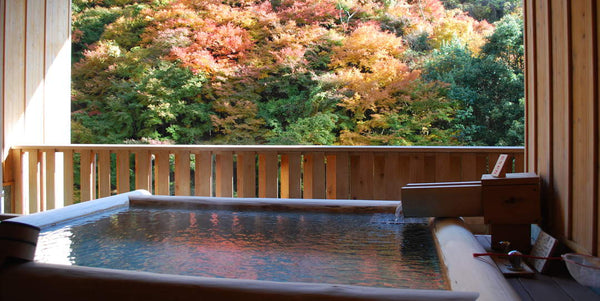Your Cart is Empty
Free Shipping on All Subscriptions Worldwide

When most visit Japan, they may head first to the trendy Harajuku district of Tokyo or perhaps take a pilgrimage to the famous active volcano, Mount Fuji. But if you want to go off the beaten path, head north to the enchanting, rural island of Hokkaido.
As the country’s second largest and northernmost island, Hokkaido attracts Japanese and international tourists alike to its untouched nature, quaint fishing villages, snow-capped ski slopes, relaxing onsen, and scenic coastlines. In the warmer months, volcanic mountains overlook fields of flowers, creating a patchwork of lavender, poppies, and sunflowers. When winter comes around, it all gets covered with a blanket of snow that reaches to the skyline.

Source: https://www.travelnation.co.uk/blog/20-amazing-things-to-do-in-hokkaido-japan
And although Hokkaido has steadily shown up on everyone’s radar as one of the country's top travel desitions, the rural island still harbors hidden gems worth exploring.
But for those less familiar with Japan’s northernmost island, its discovery begins with a snack:
On a snowy late afternoon, a man walked home after a long, invigorating day of skiing. Looking across at the hazy horizon, he noticed fluffy snowflakes begin to fall. To himself, he poetically thought:
“It’s snowing white lovers.”
The moment inspired an idea to create a snack in the image of those delicate snowflakes. The result: a cookie made of chocolate sandwiched inside white buttery biscuits. He called them the "White Lover", or Shiroi Koibito in Japanese.
Source: https://www.snakku.com/blogs/news/25598404-review-white-lovers-is-the-japanese-snack-you-need-to-get
The name stuck… and in 1976, the Shiroi Koibito confection factory opened in Sapporo, Hokkaido. Today, Shiroi Koibito has become one of the most popular Japanese cookies of all, selling over 200 million worldwide. It even earned the 1986 Monde Selection, an annual competition honoring the best food items in the world.
While in Sapporo, you can try the Shiroi Koibito for yourself and see how its made at the amusement park and museum demonstrating the history of this cherished treat. This off-the-beaten-path destination in Hokkaido has more than just tasty treats; bring the whole family to explore gardens or hop on a train ride while savoring exhibits of chocolates, cookies, and more.
FREE GUIDE - 7 HIDDEN SNACK STORES OF TOKYO
The name Sapporo probably rings a bell, especially if you enjoy beer. Although a popular destination, if you find yourself in town, you might as well check out the brewery that made Sapporo a household name.

You might already know of Sapporo as the cherished choice of beverage in sushi restaurants the world over. But did you know that this beer was born out of the country’s oldest brewery?
The government-run the Kaitakushi Brewery first opened in Sapporo in 1876. A decade later, the Sapporo Brewing Company purchased the business. Flash forward to today, Sapporo represents the top-selling Asian beer in the United States with a global net sales of approximately 279 billion Japanese yen in 2017!If you’d like to sample some sips, the global brewing company has the country’s only institution dedicated to beer at the Sapporo Beer Museum.
 |
⛩ Discover Authentic Regional Snacks You Can Only Find in JapanExplore Snakku |

As you plan your trip to Hokkaido, keep in mind that the Sapporo Snow Festival takes place for one week every February. The festival for snow and ice attracts over two million tourists to Sapporo who come to awe at ice sculptures, go snow rafting, enjoy live music, and witness the crowning of the annual “Ice Queen”. If you love a buzzing atmosphere, don’t miss it!
But for those looking to stay clear of the crowds, let’s continue our journey through Hokkaido off the beaten path...

If world-class breweries and large festivals sound a bit too mainstream for your taste, head to more remote parts of Hokkaido on a trip to the most northerly point of Japan, Wakkanai. Travelers can get to the remote city on a six-hour train ride from Sapporo. Along the ride, you’ll enjoy mesmerizing scenic views of Hokkaido and its seaside towns and nature reserves.
During your trip, you might want to hop off the train to explore the rugged Rishiri-Rebun-Sarobetsu National Park. The park consists of the Rishiri Island and Rebun Island, two small islands near the northern tip of Hokkaido. A dormant volcano overlooks the coastal scenery and nearby fishing villages here, breathtaking during any season.

In the springtime, more than 300 species of flowers blossom, covering the landscape with sweet aromas and colorful flora. Enjoy a day outdoors breathing in the briny breeze and exploring the sprawling landscape dashed with alpine flowers including the Rebun lady's slipper orchid. Hike through the wetlands while taking in breathtaking views of fields of long grass and wildflowers.
In the winter months, you may just want to stay warm and gaze across the pristine landscapes covered by snow from indoors. Or for the more thick-skinned, get off the beaten path for a snowtime adventure...
Get on your snowshoes! It’s time to trek through snow-covered mires in the Sarobetsu Wetlands. Those looking to leave their footprints in the snow (alongside the occasional animal tracks) can observe wildlife undisturbed in marshlands formed over thousands of years ago. Home to hundreds of birds and wildlife, a long walk through the Sarobetsu Wetlands could give you a glimpse of owls, foxes, white rabbits, flying squirrels, and maybe even a rare crane or two.

Source: https://www.travelnation.co.uk/blog/20-amazing-things-to-do-in-hokkaido-japan
During your snowy adventure, why not take a break to warm yourself with a hot cocoa and a bite of Japan's favorite snack, the Kit Kat? Amid the snowy forest, you can create your very own snow table while sharing a hot drink and sweet treat with friends.
If you can’t make it all the way there, get the Hokkaido experience with authentic specialty snacks sent to your home.
Give yourself a chance to thaw out by heading to one of the island’s onsens (hot springs). Hokkaido’s seismically active landscape means the island hosts some of the country’s best known onsen.

The Hell Valley, Jigoku-dani, sits further down south below Sapporo. In this ominous sounding region, 3,000 liters of piping hot water gush from the earth... and that’s every minute! Clouds of steam make the region look like the gateway to hell, indeed.
But if you want to continue your journey north from Sapporo to Wakkanai, stop at the Toyotomi Onsen. Here, miners looking for petroleum accidentally discovered hot spring water. The petroleum mixed with steaming water make for the ideal combination in treating skin conditions, leaving your skin silky smooth and healed -- a natural spa, anyone?
The Toyotomi Onsen hosts two bathing areas and sauna along with a small restaurant serving up noodles, soups, and fried pork cutlet, a local favorite. Approach the vending machine to put in your order. Then head over to the counter to pick up your meal for a truly Japanese dining experience.
And if you fancy skiing, you can hit the slopes at the local ski resort. Honestly, what better way to end a day out in the snow than warming yourself in a traditional Japenese onsen? You’ll feel spoiled for choice as the area altogether has at least seven onsens to choose from.
Head back on the train to continue your journey to the northernmost tip of Japan, Wakkanai. If you need a place to stay, book a room with a view at the Surfeel Hotel Wakkanai. Perched over the harbor, the hotel gives panoramic views of the surrounding ocean and relaxing green coastline.

Just 30 minutes away from the Surfeel Hotel, you’ll find a magical place called Soya Bay. Likely Wakkanai’s most famous landmark, Soya Bay gives unobstructed views across the ocean on a clear day. Peak out over the water for a glimpse of the small rocky islands covered in seals. You can also admire views of Rishiri Island with its dramatic volcano floating in the ocean.
Nicknamed “the kingdom of seafood” by the Japanese, fishing in Hokkaido dates back well over 2,000 years. Prehistoric cultures relied on fishing and hunting for marine animals such as whales and seals. Today, fishing villages remain all throughout the Hokkaido coastline, overlooking the ocean, welcoming guests to feast on their abundance of seafood.
The town of Esashi became known for its herring. Every May 24th, people migrate from afar on to celebrate Herring Day by eating Nishin soba, a dish of hot buckwheat noodles topped with salty-sweet dried herring simmered in soy sauce and sugar and.

While in Wakkanai, make sure to try Urokotei Seafood Restaurant, hailed as one of the best in the region. Enormous prawns and crab legs get cooked to perfection in front of diners on an open grill: a true seafood lovers dream.
But sportsmen who prefer to catch their own can find ample opportunity to fishthroughout the year. Frozen lakes during the wintertime are ideal for ice fishing. Deep sea fishing has become popular: fluke in the spring, squid in the summer, and salmon the fall. You can also enjoy fly fishing throughout the region’s lakes and rivers.
With so much unspoiled natural beauty and rich history, it comes as no surprise that Hokkaido stands out as one of Japan’s favorite travel destinations. From hidden onsens to sweet snack museums, with a deeper look, you can enjoy the road less traveled and stumble across off the beaten path attractions in the breathtaking Hokkaido.
FREE GUIDE - 7 HIDDEN SNACK STORES OF TOKYO
If you enjoyed this post, don't miss these other popular posts:
Comments will be approved before showing up.